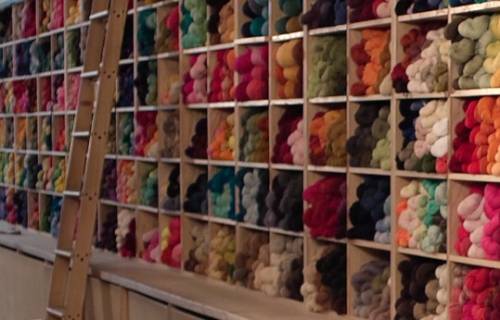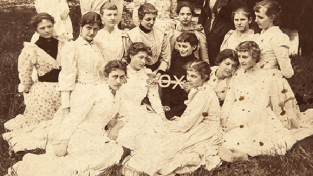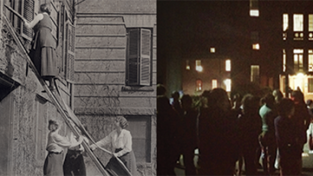Strands of Time
Unraveling Knitting’s Enduring Appeal at MHC
Often I’ve slipped back in memory to an anthropology class, Marriage and the Family, in the fall of my junior year. I sit at the end of the second row, knitting maroon wool into a sweater for my boyfriend, while up front Mr. Lobb explains how anthropologists compare cultures. In this course and many others, we are allowed, even encouraged, to knit. Learning, the theory goes, involves listening and thinking. Class discussion will illuminate material we’ve already read, while we consider concepts and, occasionally, when an idea clicks, jot something down. Today we’re covering where couples live after marriage. Matrilocal—I try to imagine newlyweds fitting in my mother’s house. Or—patrilocal—joining my future husband’s father’s family. I deliberately don’t picture my boyfriend, known to all as Turtle. I’m happy we’ve lasted six months, but don’t want pressure. And must I really get married to live with someone neolocally, in a new place? In 1970, many of us question the roles and rules of marriage and family, though we have no idea how contested they will be, for how long. I twist in my seat and scan the room. Many knit, some crochet. One girl is knotting a macramé project fastened to the far wall, while in the back another has set up a smallish loom. Someone could study us, I think, as a matriarchal tribe whose founder’s grave is in the center of our village. I make a note.
Did that thought fix the moment in my mind forever? My grandmother taught me to knit. When I got to South Hadley, I visited The Yarn Shop (“The most beautiful yarns from all over the world,” proclaimed their ad in my freshman handbook), where I bought a skein from which I whipped up the first of many watch caps for my relatives. Was it desire to make a Christmas gift for Turtle or knitterly ambition that led me to attempt my first sweater? Wanting to try working with two colors, I adapted a men’s ski pullover with snowflakes up the sleeves. Only if you looked closely could you tell (maybe) that my white “snowflakes” were turtles.
Turtle and I broke up in our senior year. The sweater had nothing to do with it.
Only much later did I hear of the “boyfriend sweater curse,” the notion that making a sweater might mean doom. Or could it just be that a certain percentage of sweater-level relationships won’t survive? Before the break-up, I’d begun an afghan for my mother. Its lace pattern was complicated, and the color she chose, “antique gold,” seemed to me dull mustard. Before finishing it, I was in graduate school where no one knitted in class, ever. I discovered I’d been in a bubble at Mount Holyoke. Elsewhere, an un-grandmotherly woman who knitted in public was the object of suspicion. Men mentioned Madame Defarge. Interest in knitting had declined and crocheting pretty much disappeared. In private, over time, I made myself a cotton shell, a mohair shawl, a Perry Ellis sweater with pleated ’80s shoulders. On trips, I’d search out a city’s only yarn shop, and find other women buying bags-ful, like the last addicts of an out-of-fashion drug. Other Mount Holyoke graduates tell me knitting was out of the question in science classes. Some mention the embarrassing clang of a dropped metal needle or being offended by people who called knitting sublimated sex, but many describe happily finishing first scarves and learning stitches from friends. Laurie Stein-Stapleford ’74 began knitting because a teacher came close to requiring it, saying, “You can’t listen if you’re busy writing.” Jan Baldini Bohn ’72 remembers a senior sociology seminar in which the professor knitted, expertly. There’s evidence this acceptance has a history. In a photo of 1949 English department lecture, students laugh and knit. The 1944 yearbook describes the afternoon hour when volunteers knitted for the military in the Mary Lyon Room, then adds, “But we are always doing knitting outside of hours, dropping our ball of yarn in classes, sacrificing the efficiency of both by trying to read and knit at the same time…” Llamarada 1942 says, “At the movies there was nothing like stretching your feet over the railing, knitting your sweater (providing it wasn’t cable-stitched) and watching Donald Duck or Charles Boyer.” Enthusiasm still bubbles in a 1917 New York Times article about war efforts at Mount Holyoke: “The girls are taking up courses in nursing and stenography and typewriting as a preparation for war work, and they knit all the time. It has now been forbidden at meal times.” Sixteen years after it left, the turtle sweater returned, along with its owner. Yes, Reader, I married him. But let me stick to the story of the sweater. It looked fine, not worn much, perhaps, but not discarded. When I first met my mother-in-law, she said she’d always thought a lot of love went into that pullover. Those patient turtles do testify to devotion, but they also remind me how I liked the process of listening and thinking while creating something with my hands. For knitting, too, what seemed an end was only hibernation. Needlecrafts came back in the ’90s, along with appreciation of almost-forgotten craftswomen’s mastery of geometry, color theory, and sculptural forms. Rebellion against manufactured sameness sparked a boom in crafting expressive garments, retro or avant-garde. Most fascinating to me has been the revolution in communal knitting, from “stitch-n-bitch” sessions in bars to guerrilla knitters’ projects that appear overnight in public spaces as protests or salutes. Knitting has been reconnected to education, including a new focus on teaching boys. Proponents of knitting programs in inner-city schools and prisons argue that use of fine motor skills helps with hyperactive restlessness, calms the mind, builds self-confidence, and leads to mastering other learning. Which isn’t so far, it seems, from where I started. After my mother’s death, as we sadly sorted through her things, my younger sister (Jerri Barrett ’83) said of course I must take what I had made. Today, in our (neolocal) home, the afghan, well-worn, is a patch of amber. I had no idea what would last, no idea how much I was stitching into memory.
—By Lynne Barrett ’72
This article appeared in the fall 2012 issue of the Alumnae Quarterly.
December 6, 2012












In the seventies my neighbor, Joan Amory, a Mount Holyoke graduate, came to teach me to knit while I was very pregnant and confined to bed. (During this time, she drove my daughter to preschool every day. Eventually, my daughter, Kelsey Hambley, went to Mount Holyoke as a result of these early influences. ) An essay was published back then in your alumni magazine about knitting during “meetings” where men were present, and the guts it took to insist this habit only empowered hearing, the ability to retain information, and focus. Remember, women were just breaking into board meetings and middle management. The urge to carve ourselves to fit the habits and styles of men in order to command respect were powerful. The Mount Holyoke graduates were on the forefront then (and now) of developing the new. This week Jane Brody wrote in the NY Times Science section of the power of handwork now backed by technology and research. Congratulations to Mount Holyoke for the guts and instincts shown on the pioneer timeline of women! I am proud to renew every year my Mount Holyoke sticker on my car…. Proud parent of a Mount Holyoke graduate, proud friend of Mount Holyoke alumni.
Ever since my mom had landed Japan near the close of 1945, for summer she sewed and for winter she knitted many wears for us three girls. How much I miss the rhythm of my whirling used strands in harmony with her winding them up into a ball, as much as her “Three Blind Mice” and “10 Little Indian Boys” she sang. She had learned English from a German teacher up in Chinto. I was quite marveled at her magical resuscitation skill of worn-out yarn, steaming it over the boiling water or even dumping it to dye into our favorite colors.
Later, studying as a Fulbright scholar and MHC fellowship graduate, what astounded me was the view of many students knitting in a huge class protected by professor’s tolerance. I wonder if they could have demonstrated that talent in Spanish class. I can vividly visualize my big sister Marilyn (Ursu) Bauriedel and the graduates in Hitchcock House wrapped themselves up in comforters against the blizzard.
And I did take this campus culture back home. I enjoyed knitting Ivy-type long shawl, sweater, and knee blanket, only at home and for my own use. It never occurred to me to try venturing to lecture and knit before my university students. The combined college education and home economics somehow struck an odd chord in me.
Retired, I have the cozy time needling scarf, skirt and bag as well as mending for little ones, to track the thoughts of my mom, who died March 2012, age 101. She’s the one who opened up my eyes to movies. “Mother’s Eyes” (1950) is quite similar to “Dancer in the Dark” (2000), shows a Japanese mom maneuvering stands.
–posted on behalf of Dr. Kiseko Ozaki Minaguchi, ’64 certificate graduate
How I enjoyed reading this article and all the comments attached to it. And I remember every one of the commenters from the ’72–’74 era who posted. I was a chemistry major and one day in Anna Jane Harrison’s thermodynamics class I sat at the top of the lecture hall—the one with the concrete steps in Carr—and decided to knit. I too knew that busy hands left your mind free to concentrate on the lecture, something I don’t think Dr. Harrison really understood. Partway through the lecture I dropped my metal needle and it bounced and clanged its way all the way down those steps. I didn’t knit in chemistry again, but did knit in my seminar classes that met in dorm living rooms.
I tried knitting in meetings at IBM, but that did not go over well at all. These days I work from home for Oracle and no one knows that I am knitting while on conference calls. My love for all needlework has grown over the years and now I embroider, needlepoint, quilt, and of course, still knit like a fiend.
–Posted on behalf of: Beth Gardner ’73
It was John Lobb (sociology department) who told the story of noticing a student starting an intricate Norwegian sweater right after Thanksgiving. He assumed she had found a new boyfriend over the Thanksgiving holiday and was disappointed when it was time to leave for Christmas vacation and he hadn’t seen the finished product…and realized he wouldn’t, as it was certainly a Christmas gift for her beau.
After Christmas break, he looked up in the class to see her emphatically unraveling the sweater stitch by stitch. They had obviously broken up over the holidays! It unnerved him so much that he was the one who mentioned in the first class of each course he gave, that it was all right to knit, but under no circumstances were you allowed to unravel!
I have told the story many times, generally to illustrate that the knitting in class made one concentrate more on the lecture and to write down only the really salient points!
–Posted on behalf of: Sarah Dunn Hoag ’63
When I entered MHC in the fall of 1954, one of my first visits was to the yarn shop, where I quickly established a charge account. I had learned to knit as a child but had never done anything major. My first project was a pair of plaid socks for my father. (I still have the pattern). During my four years I made myriad pairs of argyle and cable socks, and Shetland sweaters (knit, then brush the finished sweater with a hairbrush to raise the nap and soften the sweater).
In my junior year, Bulkeley Smith, Jr., came to the Department of Sociology and Anthropology fresh from his Ph.D. at Yale. A friend and I each knit one sock of a pair in class. We then invited him and his wife to dinner and presented him with the socks. He sported them proudly in class the next day by placing both feet on his desk and lecturing from this position for the entire duration of the class.
Although I have added needlepoint and other needle arts, knitting is still my first love and I continue to turn out sweaters, afghans, socks, etc. for my family and friends.
–Posted on behalf of: Ruth Gerard Poley ’58